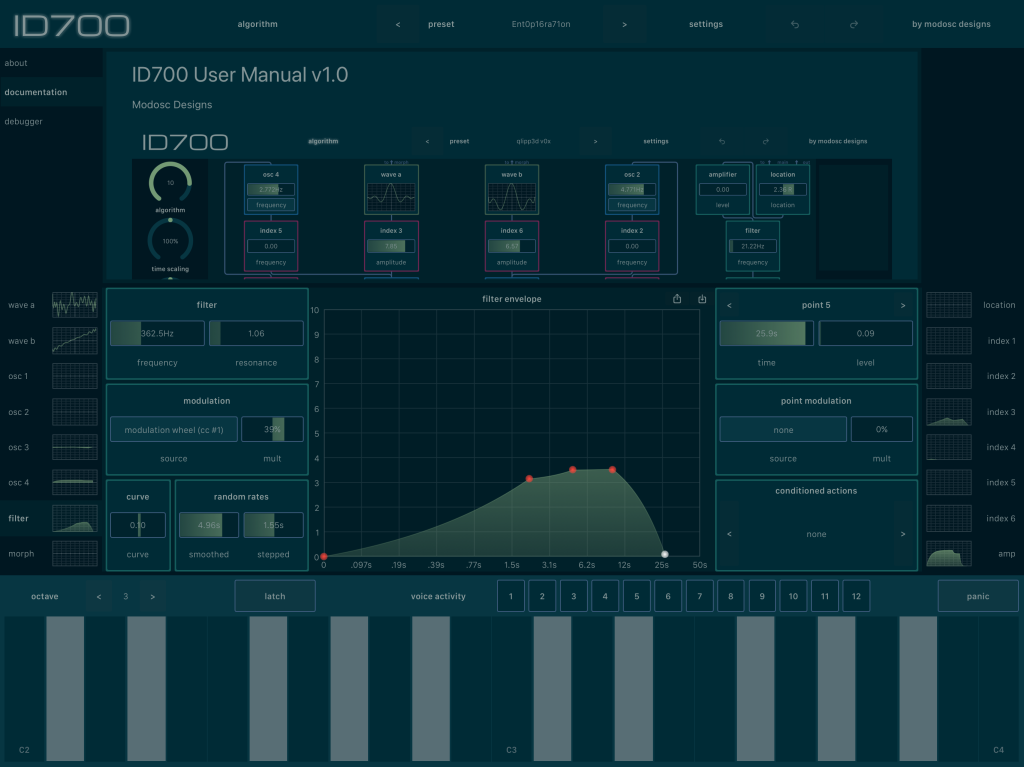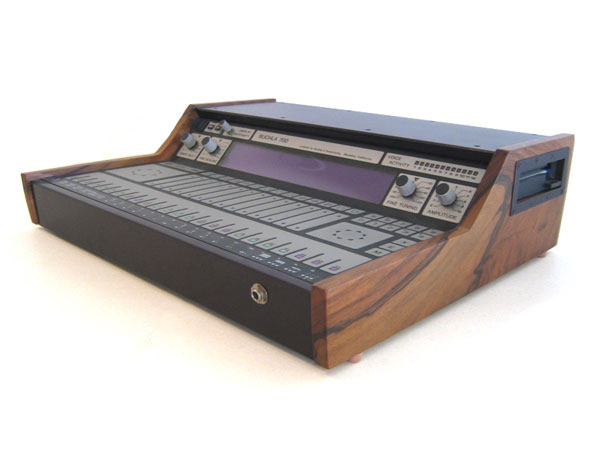It was the once and future Buchla. But back in 1987, the Buchla 700 was so painfully ahead of its time that … well, its ideal moment is probably really now, right now, on your iPad. And so you’re in luck.
ID700 is beautiful, focused, and musical. The work of modosc designs in Berkeley, the iOS app is a labor of love by one Jonathan Schatz – a musician and developer who worked directly with Don Buchla on the 200e series. And it has the insane sonic possibilities of the original, thanks to 4 oscillators per voice * 12 voice = 48 oscillators, with wildly editable envelopes (15 per voice, for 180 envelopes) and modifiers.

The iPad app is based on the voice architecture of the Buchla 700, but not slavishly so – and there’s no muddled skeuomorphism, either, which is good, because the Buchla 700 itself looked pretty wonky. So instead you get a native touch app with the deep architecture of the 700. The touchplate-style keyboard is still there, as it should be – it’s fair to say that the touch experiments of Don Buchla are part of a lineage that ultimately influenced the invention of the iPhone and iPad.
But having everything in a visual, flow-diagram interface is perfect. It means you can touch and drag to change just about any parameter, for fine-tuning frequency modulation, waveshape and timbral controls, and modulation. The ID700 app is remarkably flat; I expected some tabbed affair, but instead, you get a massively powerful single screen where everything is at reach. It honestly puts a lot of software synths to shame, and if you didn’t know the Buchla connection, I really do think you’d assume this 1989 idea came from last week.
Basically, the notion is FM synthesis with waveshaping, now with the ability to choose one of 40 wave shapes or draw in your own, and then a ton of powerful envelopes. That’s it – a recipe for FM + waveshaping + envelope the heck out of the result. Add in MPE control and tuning support, and you get a pretty perfect live instrument.

Details from the developer:
- AUv3 and IAA support on iOS
- twelve voices of four operator FM with twelve unique algorithms
- fourteen complex envelopes per voice
- two hundred professionally designed presets
- two waveshapers per voice
- over forty factory wave shapes plus an editor for user created shapes
- Scala scale file support with over four thousand included tunings from the Scala scale archive
- MPE (MIDI Polyphonic Expression) capability for MPE controllers like the Roli Seabord, Linnstrument, and Sensel Morph
I’m definitely working this into a live set, and the iPad seems an ideal place to run it – you can always just record into your host. But given the MPE support and plenty of controller options now, I’d love to see this in a macOS AUv3, too, and it sounds like that’s coming. (See the recent, excellent Model 15 and … well, if you got stuck with just this synth and that synth, you’d more or less never run out of options.
I’ll try to make more sound examples soon, but here’s an example with just one preset, showing how easy to navigate the UI is, including quick access to modulation sources and tons of draggable/touchable timbral details:
The original Buchla 700
You’d be forgiven for not knowing the Buchla 700 – mention of Buchla history usually covers the modulars and Music Easel and skips over this chapter. But it’s worth knowing. As Jonathan writes:
In 1987 Don Buchla released the Buchla 700 synthesizer. It was the next logical step from Don’s previous digital synths (the Buchla 400, Touché, Buchla 500) but was also influenced by the synth trends of the 1980’s, specifically FM synthesis and the all-in-one workstation concept. As usual, Don was ahead of the curve and the 700 never took off. Very few were sold and even fewer functioning units exist today. I always loved the sound of Don’s digital oscillators, and combined with the scarcity of the instrument it seemed like a fun project to recreate it in software and reintroduce its concepts to the world.
And it looked like this –

The creation was an analog/digital hybrid the likes of which we didn’t see again until the current generation – computer-based digital synthesis, with analog filtering, modifiers, and amps. (The analog bits are easily modeled on the iOS app.)
Inside was not one but four computers, including an 8-bit 6303 microcontroller that handled analog and digital conversion. The heart and soul was a 16-bit Motorola 68000 – yes, the same one you know from the Apple Macintosh (and Amiga, Atari ST, and whatnot). That is, in some sense the Buchla 700 was the first standalone computer-as-synth, long before custom solutions tried to cram machines into purpose-built music hardware.
Developer Lynx Crowe worked on the software.
And it has been a digital synth-lover’s haven – something others have tried to recreate (even if this app is by far the most accessible rendition). That means there are some great notes on how it’s put together:
Notes on the Buchla 700 audio synthesizer [gliftor]
Buchla 700 archeology [Johan Boberg]
And yeah, Aaron Lanterman of Georgia Tech made a version of it in SuperCollider, which is also a lot of fun both as a tour of both SC and with some ideas around 700-ish synthesis:
Basically, the 700’s time is now – as the world embraces polyphonic expression, rich polyphonic instruments with loads of envelopes, a combination of FM synthesis and waveshaping (because the world is more comfortable with the gnarly results), and the world of tuning beyond 12-TET.
700 on.
ID700 on the App Store (US$7.99 intro price now)
Read the manual (it’s lovely!)